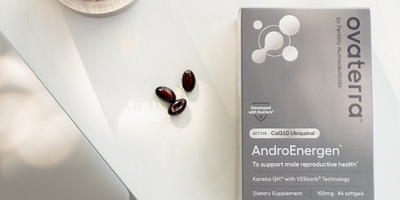Last updated: January 16, 2023
Misconceptions around male reproductive health abound. Some of these male fertility myths persist, precisely because there are some truths to them. Let's take a look at four male fertility myths with some grains of truth.
Myth: Men’s fertility doesn’t decline with age, unlike women’s.
Because a significant number of men have children in their 50s, 60s and even into the 70s (Charlie Chaplin comes to mind – he had his last child at age 73), you may think that male fertility doesn’t decline with age. This is true to a degree. While women are born with all the eggs for our lifetime which are depleted by menopause, men continue to produce sperm and can have children throughout their lives.
However, studies have shown that the quantity and quality of the sperm do decline with advancing age. Evidence is somewhat mixed on the effects of age on sperm concentration, but research suggests that sperm motility (the sperm’s ability to move) and morphology (the physical appearance of the sperm) may both deteriorate with age.
Furthermore, sperm from older men show an increased amount of DNA fragmentation, which can reduce the sperm’s chance of forming a good-quality embryo. Scientists have hypothesized that this age-related increase in DNA fragmentation may be due to the accumulation of oxidative stress over time and reduced antioxidant capacity (which fights against the negative impacts of oxidative stress on reproductive health) as men age.
Myth: Sperm production is a quick, daily process, unlike egg production.
This is also a partial truth – men do produce mature sperm daily, while women release a mature egg only once in each menstrual cycle. But daily sperm production doesn’t mean that each sperm takes just hours to be generated. Depending on the measurement methods used, scientists have estimated this process – called spermatogenesis – to take 74 days to 120 days. This is surprisingly similar to the length of time it takes for an immature egg cell to reach full maturity, ready for ovulation.
In spermatogenesis, a stem cell goes through a mitotic division and two cycles of meiotic division to form a tailless spermatid with just one set of chromosomes. Our somatic cells have two sets of 23 chromosomes, but our reproductive cells (gametes), including sperm, should have just one set of chromosomes so that the embryo that results from fertilization will have the normal two sets, with one set coming from the sperm and the other from the egg. Meiotic cell divisions ensure the accuracy of this genetic math.
To reach full maturity, a spermatid undergoes a few more transformations. First, it develops a tail by growing a tiny tubular structure attached to the part of the spermatid that eventually becomes the sperm’s head. The part of the sperm’s tail closer to the head grows thicker than the rest, with mitochondria arranged around it. These mitochondria produce the vital energy that the sperm needs to develop to maturity, swim toward the egg and eventually fertilize it.
Another important transformation is the packaging of the sperm DNA. In this process, long, loose strands of DNA becomes condensed, and forms a structure called chromatin. In this tightly packed form, DNA structure is more stable and protected from damages and errors during cell division.
At this stage, despite having grown a tail, the sperm still lacks the ability to swim and fertilize an egg. The immature sperm travels through the male reproductive tract (called epididymis) over a few days to a week, aided by muscle contraction. During this time, testosterone works on the sperm cells to remove excess cytoplasm and organelles (tiny structures within cells), which eventually gives the sperm the ability to move on its own, a final nudge toward maturity.
All this is to say: It takes quite a bit of time and complex steps for a sperm stem cell to develop into a healthy, mature sperm.
Myth: Normal sperm is a great swimmer.
As we’ve seen, this isn’t the case for most of the sperm’s development process. Until sperm reaches full maturity in the epididymis, it doesn’t have the ability to move. Epididymis also secretes a large glycoprotein – aptly named immobilin – that inhibits movement of sperm. Amazingly, until it’s in the female reproductive tract, sperm doesn’t move on its own. In most of its life and even in the fallopian tube, sperm moves passively.
This is why having fertile cervical fluid is important for your chances of conception. Sperm needs the cervical fluid's help in order to move through the female reproductive tract to meet and fertilize the egg.
The popular image of millions of sperm all racing toward the egg in the fallopian tube is also somewhat misleading. While a male body generates millions of sperm cells every day, a significant portion of that sperm cannot swim even when fully mature. The ones that can swim often don’t swim in the right direction, either – in fact, their ability to swim toward the egg is one of the important parameters (called progressive motility) an andrologist uses to evaluate the quality of sperm in sperm analysis.
Myth: Wearing briefs and taking a hot bath damage male fertility.
“Don’t wear tight underwear and avoid hot baths” is a relatively common lifestyle factor tips given out to men who are trying for a pregnancy. It is true that the optimum temperature for sperm production appears to be about 2 degrees (Celsius) below normal body temperature, so it’s reasonable to try to avoid things that could raise the testicular temperatures.
Studies have indeed found that excessive exposure to heat can decrease sperm count and motility. Based on animal and human studies, scientists have posited that this may be due to the increase in testicular metabolism and oxidative stress, which leads to DNA damage and premature death of sperm cells.
However, the effect appears to be temporary and reversible. So, taking a hot bath or enjoying a sauna every once in a while should not lead to permanent damage to male fertility – and wearing briefs doesn’t raise testicular temperature enough to lead to clinically meaningful change in sperm parameters. Scientists think that prolonged and repeated exposure to excessive heat is more of a concern, especially for men who are exposed to higher heat through occupation. (One review even focuses on the potential effects of global warming.)
If you are looking to optimize male fertility through lifestyle factors within your control, quitting smoking, moderating alcohol consumption, reducing avoidable stress, staying active and eating healthy likely have a larger impact than wearing loose underwear and avoiding hot baths. That's especially true if you find hot baths relaxing, as stress management is an important tool in our toolbox to maintain your reproductive - and general - health.












